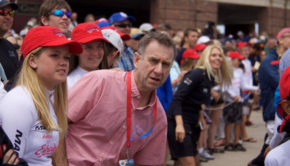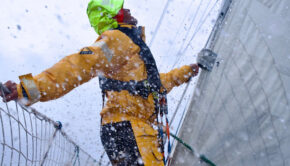Brushing Up On Downwind Tactics For Thistle Nationals
Published on August 5th, 2013
By Mike Ingham
(August 5, 2013) – At 109 boats, the Thistle Nationals (August 3-9) is underway. With such a big fleet, a few of us just got into a discussion on downwind tactics and how they differ from small fleets. The leaders won’t have a lot of clear lanes and can get locked into the side of a run pretty easily, so careful planning and excecution is key.
We can simplify the downwind tactics by following some basic rules of thumb. In light air chase pressure, in meduim wind pay attention to shifts and pressure, and in heavy air take the long tack. All while keeping your air clear. I am pretty sure if all you did was these basic things, you will have successful runs 80% of the time. The other 20% of the time, success will come from a heads up approach, great boathandling, good speed, and a little luck.
Lets take a look at our common conditions and work through the priorities for each:
In heavy air, take the long gybe. Because the angles are soo deep in heavy air, the long gybe is the gybe you will take for the majority (or all) of the run. The windier it is the more important this is – even if the course is just a little skewed, it is quite possible you will lay the leeward mark on the long gybe.
There are a few cool ways to figure out what the long gybe is:
On which tack did you spend the most time? The opposite gybe will the long gybe.
Was there a shift near the top mark? If one tack was lifted, the opposite gybe will be the long gybe and put you in phase. And once on the run, if you are headed above it, you are likely on the short gybe. In heavy air, if you are not on the long gybe you better have a great reason – if not, gybe!
In light air, head towards pressure. Most boats have wide angles downwind in light air, so you can get separation from your competitors and you can get to a side. Small differences in pressure lead to big differences in speed. For example, suppose it is blowing 4 kts and you get to a side with 6kts, well you will likely increase your speed from 2kts to 4kts -no amount of angle can make up for that! In light air, if you are not headed for wind you better have a good reason – if you can’t come up with one, gybe!
In medium breeze, both pressue and angle need to be considered. Sail the headed gybe. If you come into the weather mark on a lift, then you will need to gybe, but if you come in on a header you continue on starboard. Then gybe when you get lifted so you get onto the new headed gybe. But, also head toward pressure. Staying in pressure will allow you to sail lower and faster. Keep track of the long gybe, if in doubt stay on the long gybe and that will help keep you in phase, and keep you from reaching an edge and running out of options.
Pressure or shift – you may well ask which is more important. Unfortunately the answer is “it depends”. If the shifts are big, then they trump, if the puffs are big they take priority. The lighter it is, the bigger the speed difference and the more pressure matters, and the heavier, the more shifts matters because speed increases will only be incremental
In big fleets, the above is harder to execute because there is traffic and lots of boats behind (hopefully) giving you bad air. So the keys to succes in big fleets is to decide what gybe you want to be before you get to the weather mark, then keep that in mind so you can set up so you can get on that gybe quickly.
The next key is traffic management. In small fleets you can go where you want, but you need to not get hooked on the wrong side of boats when there are lots of them. And finally, you have to constantly manage your wind so that you keep clear of dirty air (the subject of my next article). Report








 We’ll keep your information safe.
We’ll keep your information safe.